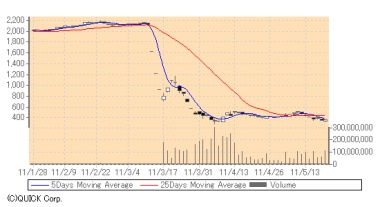Tokyo Electric Power Company (Tepco) announced the ¥1.02 trillion cost so far of reparations from natural disasters has pushed it to a ¥1.25 trillion ($15 billion) loss for the financial year just ended.
This unprecendented loss triggered the resignation of company president Masataka Shimizu as the firm reorganised to face a dramatically different future than had been planned. Gone are mid-term goals for growth and a low-carbon society; instead have come a new department dedicated to stabilisation, drastic spending cuts and a major asset sale.
The decision to write-off the four ruined reactors at the Daiichi plant was reiterated, while former plans for two Advanced Boiling Water Reactors to be built there have been scrapped by the board in a recognition of public opinion.
The company now has essentially just two priorities: stabilising Fukushima Daiichi and recovering proper generation capacity. Tepco should be able to meet the coming months' demand in the Tokyo area, it said, noting plans to quickly bring back fossil plants still offline after the natural disasters. New gas turbines will be put in place and more power will be bought from other utilities.
 |
| Tepco shares rose by a marginal 2.51% today, having hovered at four fifths of pre-tsunami levels for weeks |
Disaster impact
Damage to fossil facilities and grid infrastructure from the 11 March natural disasters was put at ¥49.7 billion ($608 million) and ¥83.3 billion ($1.01 billion) respectively, while the direct cost of emergency measures at the Fukushima Daiichi site was some ¥426.2 billion ($5.21 billion).
This was complimented by additional nuclear costs, such as keeping six undamaged reactors at Daiichi and Daini in cold shutdown (¥211.8 billion, $2.59 billion) and starting to decommission units 1 to 4 (¥207.0 billion, $2.53 billion). Scrapping plans for two new reactors at Fukushima Daiichi was slated as a loss of ¥39.3 billion ($480 million). The final cost of compensation to the thousands of evacuees was not even hinted at apart from that it would be met in compliance with law and with support from government.
In response to its new outlook the company is starting a major push to raise cash and cut spending. A "rapid" real estate sale could include some offices and facilities worth up to ¥600 billion ($7.3 billion). The closure of gymnasiums and recreation facilities would add a further saving, while there will be no investment in anything not required for power supply, public safety or legal requirements.
Taking over as president is Toshio Nishizawa, who will be joined by Zengo Aizawa as the new executive vice president. At their top level, these men will recieve no wages at all under new cutbacks. Other employees are on a sliding scale from 60% down to 20% of former pay according to rank. This covers all of Tepco's 38,000 workers and should save ¥54 billion ($660 million).
The company said it could not make any predictions on its financial situation next year. Tepco shares actually rose by 2.51% on the Tokyo Stock Exchange - although trading at just ¥367 each, down from ¥2197 in February.
Stabilisation
The dedicated stabilisation department is to be based in the nearby Daini plant, with separate sub-departments focused on each of Tepco's roadmap goals for Daiichi. Combined with offices to support evacuees and pay compensation, some 5000 people will work on the project. Tepco noted that staffing needs will be monitored closely and scaled up and down as appropriate.
With four reactors destroyed, plans for two new ones scrapped and six more shut down for the forseeable future, Tepco did not comment on future nuclear plans. However, an organisational chart did include an office for new build in Higashidori, where construction on an Advanced Boiling Water Reactors was meant to start this year, with another following in 2014.
Researched and written
by World Nuclear News




_47120.jpg)

_23621.jpg)






